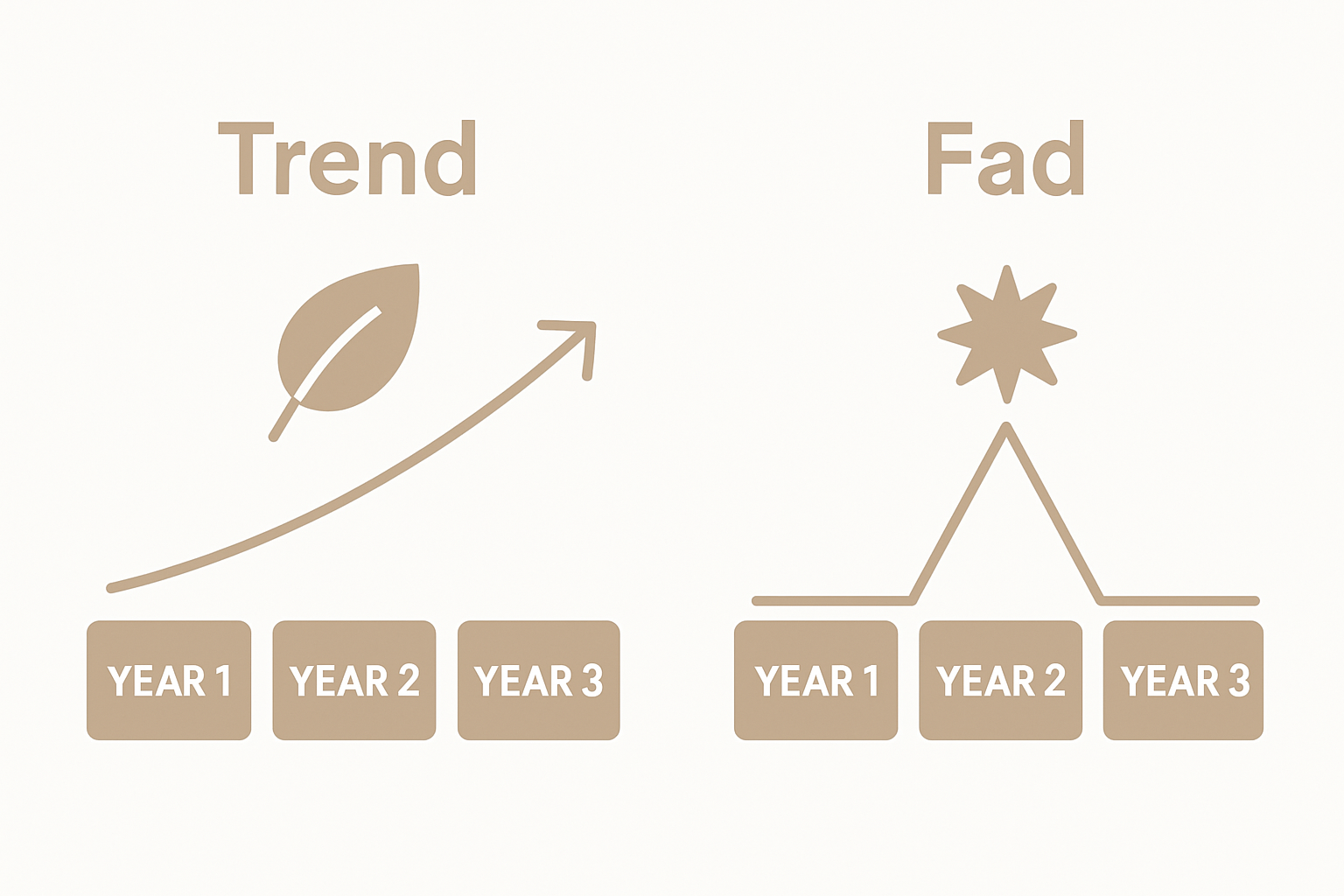Understanding the Difference Between Trends and Fads
Trends and fads shape everything from the way we dress to the places we travel. Some fashion crazes explode in popularity only to vanish within a year, while others stick around and reshape entire industries. Most people assume they already know the difference between the two, but the real difference runs much deeper than simply how long something lasts.
Table of Contents
- Defining Trends And Fads: Key Characteristics
- The Lifecycle Of Trends And Fads: How They Evolve
- The Impact Of Trends And Fads On Culture And Society
- Why Understanding Trends Vs. Fads Matters For Women
- Real-World Examples Of Trends And Fads In Fashion And Travel
Quick Summary
| Takeaway | Explanation |
|---|---|
| Understand trends’ long-term relevance | Trends evolve gradually and retain significance, influencing various sectors over time. |
| Recognize fads’ ephemeral nature | Fads are short-lived phenomena, driven by rapid popularity without lasting impact. |
| Empower personal choices through discernment | Knowing the difference aids intentional decisions in style and consumption. |
| Observe the impact on social dynamics | Trends and fads shape group behavior and reflect societal values in all contexts. |
| Identify real-world examples | Analyzing fashion and travel can clarify trends versus fads in cultural contexts. |
Defining Trends and Fads: Key Characteristics
Understanding the distinction between trends and fads requires careful examination of their unique characteristics and social dynamics. While these terms are often used interchangeably, they represent fundamentally different patterns of consumer behavior and cultural adoption.
What Defines a Trend
A trend represents a sustained pattern of change or development that evolves gradually and maintains relevance over an extended period. According to psychological research on consumer behavior, trends emerge from deeper societal shifts, reflecting more profound cultural transformations. Unlike fleeting phenomena, trends demonstrate considerable staying power and typically influence multiple sectors simultaneously.
Key characteristics of trends include:
- Long-term sustainability and gradual evolution
- Broader cultural or social significance
- Meaningful adaptation across different domains
- Slower but more consistent growth pattern
Understanding Fads: Temporary Phenomena
Fads, in contrast, represent short-lived bursts of intense popularity that rapidly emerge and quickly disappear. These temporary phenomena capture widespread attention momentarily but lack the substantive foundation required for long-term relevance. Fads are characterized by their explosive yet ephemeral nature, often driven by immediate emotional responses or media-driven excitement.
For fashion enthusiasts interested in deeper insights, read our guide on understanding timeless vs trendy fashion choices, which explores these nuanced distinctions.
The primary differences between trends and fads can be distilled into three critical dimensions:

- Duration of cultural impact
- Depth of societal integration
- Potential for sustained transformation
Ultimately, comprehending the difference between trends and fads allows individuals to make more informed decisions about personal style, investment choices, and cultural engagement.
Below is a table comparing the key characteristics of trends and fads, allowing for quick reference and deeper understanding at a glance.
| Aspect | Trends | Fads |
|---|---|---|
| Duration | Long-term, evolve gradually | Short-lived, rapid rise and fall |
| Cultural Significance | Reflect deeper societal changes | Driven by immediate excitement |
| Spread | Slow, organic adoption across domains | Rapid, viral proliferation |
| Staying Power | High, often influencing multiple sectors | Low, rarely leaves lasting impact |
| Examples | Sustainable fashion, eco-conscious travel | Bucket hats, selfie tourism |
| Integration | Broader adaptation across different areas | Limited to a narrow context |
| While trends represent meaningful progression, fads serve as momentary expressions of collective excitement, each playing a unique role in our dynamic social landscape. |
The Lifecycle of Trends and Fads: How They Evolve
The progression of trends and fads represents a complex social phenomenon that follows distinctive patterns of emergence, adoption, and eventual transformation.
Understanding these evolutionary cycles provides critical insights into how cultural and consumer behaviors shift and propagate.
Initial Emergence and Spark
Every trend and fad begins with an initial spark of innovation or inspiration. According to sociological research on cultural diffusion, these initial moments often emerge from niche communities, creative industries, or influential individuals who introduce novel concepts. The critical difference lies in how these initial sparks develop and spread.
Key stages of initial emergence include:
- Identification of a novel concept or approach
- Introduction within specialized or creative circles
- Early recognition by trendsetters and innovators
- Potential for broader social resonance
Adoption and Proliferation Dynamics
Trends and fads diverge significantly during the adoption phase. Trends demonstrate a gradual, organic spread across broader social segments, while fads experience rapid but short-lived viral proliferation. Technological platforms and social media have dramatically accelerated these processes, enabling faster and more extensive communication of cultural phenomena.
Learn more about current fashion trends and their evolving landscape to understand how modern communication channels reshape trend dynamics.
The proliferation process involves several nuanced stages:
- Initial curiosity and experimental adoption
- Mainstream recognition and broader appeal
- Peak popularity and widespread engagement
- Potential integration or decline
Ultimately, the lifecycle of trends and fads reflects broader social mechanisms of innovation, communication, and collective imagination. While trends represent sustained cultural shifts with meaningful progression, fads capture momentary collective enthusiasm, each playing a unique role in our dynamic social ecosystem.
The following table outlines stages in the lifecycle of trends and fads to clarify how they evolve and differ in adoption and influence over time.
| Lifecycle Stage | Trends | Fads |
|---|---|---|
| Initial Emergence | Introduced through niche innovation | Initiated by sudden popularity |
| Early Adoption | Recognized by trendsetters, slow adoption | Immediate mainstream attention |
| Proliferation | Gradual spread into broader society | Rapid, widespread engagement |
| Peak Popularity | High visibility, integrated into culture | Explosive interest, oversaturation |
| Decline/Integration | Integrates into norms or evolves sensibly | Abrupt drop in interest, forgotten |
The Impact of Trends and Fads on Culture and Society
Trends and fads are powerful social mechanisms that reflect and shape collective human behavior, serving as dynamic indicators of societal values, technological advancement, and cultural transformation. Their influence extends far beyond surface-level popularity, penetrating deep into social structures and individual psychologies.
Social Dynamics and Collective Behavior
Social movements are profoundly influenced by how trends and fads emerge and spread. According to research on cultural diffusion, these phenomena reveal intricate patterns of group psychology, demonstrating how communities adopt and reject collective ideas. Trends represent structured social evolution, while fads capture momentary emotional resonance.
Key social impact dimensions include:
- Reflection of underlying cultural values
- Mechanism for group identity formation
- Platform for individual self-expression
- Indicator of societal transformations
Economic and Cultural Implications
Beyond social psychology, trends and fads generate substantial economic momentum across multiple industries. Fashion, technology, entertainment, and consumer goods are continuously reshaped by these dynamic cultural forces. Explore how music influences fashion trends to understand the interconnected nature of cultural expressions.
Significant economic consequences involve:
- Driving consumer spending patterns
- Stimulating product innovation
- Creating and disrupting market opportunities
- Influencing brand strategies
Ultimately, trends and fads serve as complex communication systems, enabling societies to experiment with ideas, challenge existing norms, and collectively imagine alternative possibilities. They represent more than mere consumer behaviors they are sophisticated social technologies through which humans negotiate meaning, identity, and shared experiences.
Why Understanding Trends vs. Fads Matters for Women
In a rapidly evolving cultural landscape, women navigate complex social expectations and personal expressions through their understanding of trends and fads. Recognizing the nuanced differences between these phenomena empowers women to make intentional choices about personal style, professional presentation, and individual identity.
Personal Empowerment and Self Expression
According to historical research on women’s cultural agency, understanding trends and fads provides women with critical tools for strategic self-representation. Discernment becomes a form of personal power, enabling women to distinguish between temporary excitement and meaningful personal evolution.
Key aspects of personal empowerment include:
- Developing a curated personal aesthetic
- Resisting unconscious social pressures
- Making financially intelligent consumption choices
- Maintaining individual authenticity
Professional and Social Strategic Positioning
Trends and fads play significant roles in professional and social environments where perception and presentation carry substantial weight. Learn more about the difference between fashion and style to understand nuanced personal branding strategies.
Strategic considerations involve:
- Building a consistent professional image
- Understanding industry-specific visual languages
- Balancing innovation with timeless elegance
- Communicating confidence through informed choices
Ultimately, women who comprehend the distinction between trends and fads transform passive consumption into active, intentional cultural participation. This understanding transcends mere fashion choices, representing a sophisticated approach to personal narrative and social engagement.

Real-World Examples of Trends and Fads in Fashion and Travel
Examining concrete examples provides clarity on the intricate differences between trends and fads across various domains. These real-world illustrations demonstrate how cultural phenomena emerge, spread, and ultimately transform social landscapes.
Fashion Dynamics: From Ephemeral to Enduring
Contemporary fashion trends represent complex social narratives, revealing nuanced shifts in collective aesthetic preferences. According to historical research on consumer behavior, certain phenomena capture momentary cultural imagination while others establish lasting influence.
Fashion examples illuminate these distinctions:
- Sustainable fashion: A meaningful trend reflecting environmental consciousness
- Y2K aesthetic revival: A contemporary trend with nostalgic roots
- Bucket hats: A relatively short-lived fad with rapid popularity
- Platform shoes: A cyclical trend with periodic resurgence
Travel and Lifestyle Manifestations
Travel experiences similarly demonstrate the intricate interplay between trends and fads. Transient phenomena often reveal deeper societal transformations, showcasing how collective behaviors reflect broader cultural shifts.
Notable travel and lifestyle examples include:
- Minimalist digital nomad lifestyle: An emerging long-term trend
- Selfie tourism: A short-lived fad driven by social media
- Eco-conscious travel: A sustained trend with meaningful societal impact
- Extreme adventure tourism: A cyclical trend with periodic popularity
These examples underscore how trends and fads function as sophisticated communication systems, enabling societies to experiment with collective imagination and challenge existing paradigms. By understanding these dynamics, individuals can make more intentional choices about personal expression and cultural participation.
Discover Your Own Enduring Style—Not Just Another Passing Phase
If you found yourself wondering how to tell the difference between lasting trends and fleeting fads, you are not alone. So many women strive for a wardrobe that feels timeless and authentic, but the whirlwind of ever-changing fads can make it hard to know where to start. As you read in the article, finding clarity between passing excitement and true personal evolution is key for building confidence and expressing your real self. That sense of empowerment comes from understanding what speaks to your heart and lasts beyond the moment.

Ready to step into a world where your style reflects your deepest values and stands the test of time? Explore Be Juliet’s curated selection of modern, inspired, and timeless pieces. Every garment is thoughtfully designed to resonate with your individuality—whether you are in the mood for elegance, comfort, or pure self-expression. Discover more about the difference between fashion and style, then unleash your personal narrative with our full collection. Your transformation from trend-follower to trendsetter starts today. Visit Be Juliet now and make every outfit a true reflection of you.
Frequently Asked Questions
What is the main difference between a trend and a fad?
A trend is a sustained pattern of change that evolves over time and maintains relevance, while a fad is a short-lived phenomenon characterized by rapid popularity that quickly wanes.
How can I identify if something is a trend or a fad?
To identify a trend, look for long-term sustainability, cultural significance, and consistent growth. A fad, on the other hand, is marked by explosive but temporary popularity, often driven by immediate emotional responses or media hype.
Why is it important to understand trends and fads in fashion?
Understanding trends and fads allows individuals to make informed decisions about personal style and investments, helping to distinguish between fleeting excitement and meaningful changes in fashion.
How do trends and fads affect consumer behavior?
Trends can drive long-term consumer spending patterns and create lasting market opportunities, while fads typically stimulate short-term spikes in interest and purchases, often leading to quick declines once the excitement fades.
